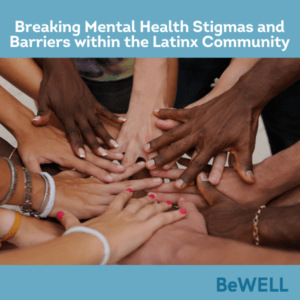Each person’s life experience is unique; however race, culture, gender, and socio-economic status will be influential on the experience. These experiences will determine stressors and how we respond to stressors. When stressors occur in life, it often impacts a person’s mental health and they become more open to the idea of mental health treatment. The receptiveness of mental health treatment will be based on the person’s culture, accessibility, and the ability to connect with the provider. For some cultures there is a hesitation with obtaining mental health services due to mistrust in communities with the mental health system. Research has shown that African American and Latino communities in the US have expressed mistrust of clinicians as a product of historical persecution as well as current issues of racism and discrimination (Gopalkrishnan 2018). The challenges that this discussion on the historical perspective raises is around mental health systems that can work in more collaborative and power-sharing ways, and that work deliberately toward empowering the communities that they work with (Gopalkrishnan 2018).
When seeking services, especially for people in the minority community, there is hesitancy not only based on mistrust, but lack of cultural competence, as well as lack of diversity in the field. As an African American woman, when I seek any type of services, I consider the following: will the person understand or relate to my culture or struggle, will they care, do they actually want to help me, and are they invested in me as a person. These questions are not only important for me but important to anyone seeking mental health services. Considering the mistrust experienced by the minority community and the need for cultural competence, it is essential that mental health service providers are diverse. Diversity in mental health treatment will not only allow the client to have options in regard to providers, but also eliminate the burden of explaining cultures, customs, experiences of racism, and/ or discuss the impact of living as a person of color and its impact on daily life stressors. Working with a person of color does not automatically mean a shared experience, however having the option of speaking with someone who may be able to relate to cultural concerns will be truly beneficial.
Approximately 548,000 adults (9 %) in New York City experienced depression in 2016, of this percent Latino adults (13 %) experienced depression at nearly twice the rate of White (7 %), Black (8 %) and Asian and Pacific Islander (5 %) adults (New York City Department of Health 2018). Considering this data, the question that is often considered is, “What does the mental health providers ratio look like based on race and culture”? According to the American Psychological Association, in 2015, 86 percent of psychologists in the U.S. workforce were white, 5 percent were Asian, 5 percent were Hispanic, 4 percent were black/African American, and 1 percent were multiracial or from other racial/ethnic groups.1 This is less diverse than the U.S. population as a whole, which is 62 percent white and 38 percent racial/ethnic minority (American Psychological Association 2015). Considering this data, it can be a daunting experience in regard to finding a mental health provider based on race and culture. These statistics influenced me as an African American female in regard to furthering my education in the field in order to provide mental health services in my community. I also encourage people of color to promote change in our communities, especially by focusing on mental health services. People of color should not only utilize the services, but also work in the field in order to be a part of the much-needed diversity in this field.
Educating the Community on Mental Health Treatment and Finding Services Providers based on Race and Culture
Mental health treatment in communities with people of color continue to experience stigma and avoidance of services, however with education in regard to the benefits with the utilization of services, mental health treatment may be more embraced. People of color may also consider mental health treatment if they feel services will be rendered by people who resemble their race, culture, and gender. People of color should also be educated on mental health treatment evolving with technology. The evolution of technology has allowed telehealth services, which are mental health services provided through video or tele remotely. While this service has become extremely popular during the pandemic, this option provides people of color with receiving diverse services no matter their location. Location often plays a role in obtaining diverse services. Certain communities are more diverse than others which will impact diversity in treatment in certain areas. Telehealth services allows for people of color to seek providers they are more comfortable with despite their location. Another great feature with technology is websites tailored to finding diverse mental health providers. These websites allow a perspective client the option of looking at pictures of the mental health provider, reviewing their specialty, filtering race, language, and gender.
By educating people of color in regard to options of diverse mental health providers, there will be buy-in from the community with utilizing services. In turn, people of color will not only utilize the services they will be interested in providing the services to their community. As previously mentioned, as a woman of color, my providers ability to relate to me culturally will impact my utilization of services. From first-hand experience, I can say that the field requires more diversity, however this empowered me to be a part of the change that is very much needed. I encourage people of color to not only utilize the services, but to be a part of the diversity needed in the field. More diversity in the field will not only assist with different races and culture embracing mental health services, but also remove stigmas associated with treatment, incorporate racial bias, impacts of oppression, and culture into treatment. Mental health in communities of people of color are becoming a priority and in order to meet the demands of this priority it is essential for diversity in treatment.
References:
Gopalkrishnan. (2018). Cultural Diversity and Mental Health: Considerations for Policy and Practice. Front Public Health, 179.
https://www.ncbi.nlm.nih.gov/pmc/articles/PMC6018386/
Department of Health. (2018, April 16). Health Department Releases First Comprehensive Report on Depression Among Adults in New York City.
Https://Www.Ncbi.Nlm.Nih.Gov/Pmc/Articles/PMC6018386/.
https://www1.nyc.gov/site/doh/about/press/pr2018/pr026-18.page
American Psychological Association (2015). Demographics of the U.S. psychology workforce: Findings from the American Community Survey. Washington, DC: Author



